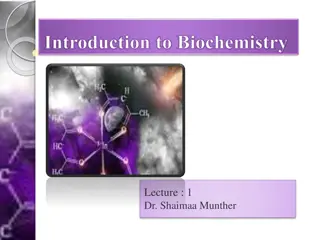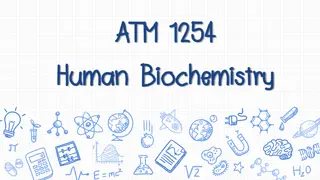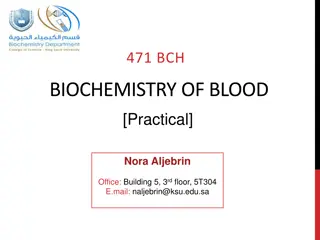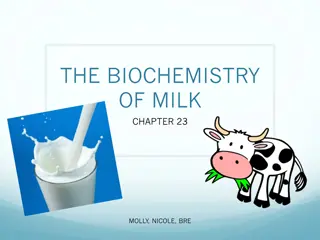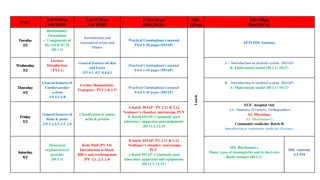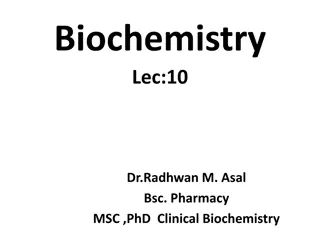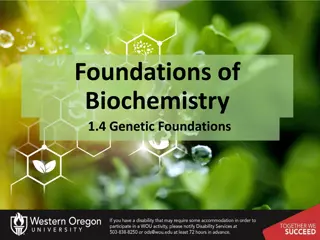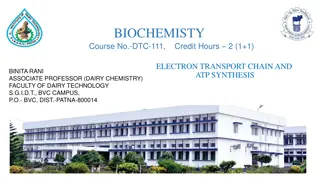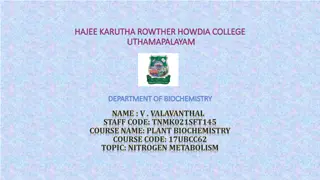Understanding the Scope and Importance of Biochemistry
Biochemistry is a crucial field that delves into the chemical processes of living organisms at a cellular and molecular level. It aids in understanding diseases, molecular interactions, metabolism, and the origins of life. By studying the structure and function of complex molecules, biochemistry forms the basis of various life sciences, including genetics, cell biology, and pharmacology. Medical and veterinary students benefit greatly from biochemistry as it equips them to address health maintenance, disease treatment, cancer causes, genetic disorders, and drug design.
Download Presentation

Please find below an Image/Link to download the presentation.
The content on the website is provided AS IS for your information and personal use only. It may not be sold, licensed, or shared on other websites without obtaining consent from the author. Download presentation by click this link. If you encounter any issues during the download, it is possible that the publisher has removed the file from their server.
E N D
Presentation Transcript
UNIT-I Scope and Importance of Biochemistry
Biochemistry Biochemistry has become the foundation for understanding all biological processes. It has provided explanations for the causes of many diseases in humans, animals and plants 2 Anil Gattani, Ajeet Kumar
What is Biochemistry ? Biochemistry is the application of chemistry to the study of biological processes at the cellular and molecular level. It emerged as a distinct discipline around the beginning of the 20th century when scientists combined chemistry, physiology and biology to investigate the chemistry of living systems by: Studying the structure and behavior of the complex molecules found in biological material and A. the ways these molecules interact to form cells, tissues and whole organism B. 3 Anil Gattani, Ajeet Kumar
Biochemistry Aim: to describe and explain, in molecular terms, all chemical processes of living cells Structure-function Metabolism and Regulation How life began Anil Gattani, Ajeet Kumar
Biochemistry Significance: be essential to all life sciences as the common knowledge Genetics; Cell biology; Molecular biology Physiology and Immunology Pharmacology and Pharmacy Toxicology; Pathology; Microbiology Anil Gattani, Ajeet Kumar
Biochemistry Medical/Veterinary students who acquire a sound knowledge of biochemistry will be in a strong position to deal with two central concerns of the health sciences: (1) the understanding and maintenance of health (2) the understanding and effective treatment of disease Causes of cancers, etc Molecular lesions causing various genetic diseases Rational design of new drugs Anil Gattani, Ajeet Kumar
Principles of Biochemistry Cells (basic structural units of living organisms) are highly organized and constant source of energy is required to maintain the ordered state. Living processes contain thousands of chemical pathways. Precise regulation and integration of these pathways are required to maintain life Certain important pathways e.g. Glycolysis is found in almost all organisms. All organisms use the same type of molecules: carbohydrates, proteins, lipids & nucleic acids. Instructions for growth, reproduction and developments for each organism is encoded in their DNA 7 Anil Gattani, Ajeet Kumar
History and developmentof Biochemistry 1903, Neuberg (German): Biochemistry Chemistry of Life Anil Gattani, Ajeet Kumar
Two notable breakthroughs (1) Discovery of the role of enzymes as catalysts (2) Identification of nucleic acids as information molecules Flow of information: from nucleic acids to proteins DNA RNA Protein Anil Gattani, Ajeet Kumar
Some historic events In 1937 Krebs for the discovery of the Citric Acid Cycle-won the Nobel Prize in Physiology or Medicine in 1953 In 1953 Watson & Crick for the discovery of the DNA Double Helix -won the Nobel Prize in Physiology or Medicine in 1962 Anil Gattani, Ajeet Kumar
In 1955Sanger for the determination of insulin sequence- won the Nobel Prize in Physiology or Medicine in 1956 In 1980 Sanger & Gilbert for Sequencing of DNA- won the Nobel Prize in Chemistry in 1980 In 1993, Kary B. Mullis for invention of PCR method -won the Nobel Prize in Chemistry in 1993 Anil Gattani, Ajeet Kumar
Organization of Life elements simple organic compounds (monomers) macromolecules (polymers) supramolecular structures organelles cells tissues organisms Anil Gattani, Ajeet Kumar
Range of the sizes of objects studies by Biochemist and Biologist 1 angstrom = 0.1 nm Anil Gattani, Ajeet Kumar
What dose the Biochemistry discuss? structure and function of cellular components proteins, carbohydrates, lipids, nucleic acids and other biomolecules Metabolism and Regulation Gene expression and modulation DNA Protein RNA Anil Gattani, Ajeet Kumar
Monomers /Polymers/Macromolecule Each of these types of molecules are polymers that are assembled from single units called monomers. Each type of macromolecule is an assemblage of a different type of monomer. Anil Gattani, Ajeet Kumar
Many Important Biomolecules are Polymers lipids proteins carbo nucleic acids fatty acid amino acid glucose nucleotide monomer phospholipid protein subunit cellulose DNA polymer supramolecular structure membrane protein complex cell wall chromosome Anil Gattani, Ajeet Kumar
How do monomers form polymers? In condensation reactions (also called dehydration synthesis), a molecule of water is removed from two monomers as they are connected together. Anil Gattani, Ajeet Kumar
Anabolic Building block Simple sugar Amino acid Nucleotide Fatty acid Macromolecule Polysaccharide Protein (peptide) RNA or DNA Lipid Catabolic Anil Gattani, Ajeet Kumar


